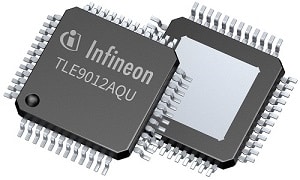- Infineon’s new BMS IC maintains longevity of batteries in hybrid and electric cars
- It also lessens the disruptions caused by interfering signals on the measurement results
 Battery management systems (BMS) ensure that the capacity of a battery is optimally utilized so that the longest possible range is achieved by an electric car and that the battery does not age prematurely. Additionally, they determine the battery’s state of charge and state of health in for estimating the available range and service life.
Battery management systems (BMS) ensure that the capacity of a battery is optimally utilized so that the longest possible range is achieved by an electric car and that the battery does not age prematurely. Additionally, they determine the battery’s state of charge and state of health in for estimating the available range and service life.
Infineon Technologies has expanded its battery management systems portfolio with new sensing and balancing IC, the TLE9012AQU. The device is especially designed for batteries in hybrid and electric cars but is suitable for other applications as well. It measures the voltage in up to 12 battery cells with an accuracy of ± 5.8 mV over the entire temperature and voltage range as well as the operating life cycle. Furthermore, it supports up to five external temperature sensors and uses an iso-UART interface for communication.
The TLE9012AQU provides the necessary measurement data and ensures a balanced state of charge through cell balancing. Among other things, this prevents the weakest cell from determining the total usable capacity of the battery.
Reduces measurement errors
To lessen the influence of interfering signals on the measurement results, the new sensing and balancing IC from features a programmable noise filter. The measurement in all cells is performed simultaneously so that the results remain comparable even in the presence of temporary interference factors. A compensation algorithm with integrated stress sensor and extended temperature compensation ensures the long-term stability of the measurements.
Achieves cell balancing
Cell balancing is achieved via 12 balancing switches integrated on the chip – one per channel. They are designed for currents up to 150 mA. For higher balancing currents, the device also supports external switches. The cell balancing can be programmed to stop without a signal from the microcontroller after a defined time of up to 32 hours or when the cell has reached a defined voltage. This allows the microcontroller to switch to sleep mode and thus save energy.
With its twelve channels, the TLE9012AQU is particularly suitable for batteries that are partitioned with twelve cells per module. One device is then required per module. The iso-UART interface for data exchange between these modules and with the MCU allows easy voltage isolation and ensures data integrity. The communication supports more than 20 serially connected devices and ring topology. This ensures that even if a single device fails, the communication chain is not broken and the rest of the system remains functional.
Along with the TLE9012AQU, Infineon is launching a matching iso-UART transceiver component (TLE9015QU). Both devices will be available in July 2020.








